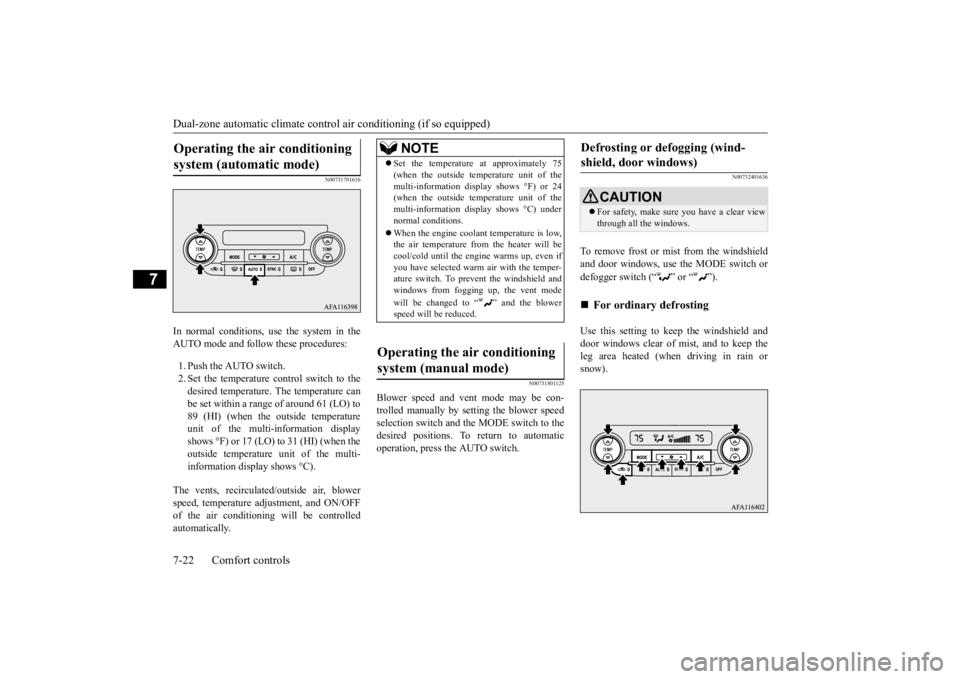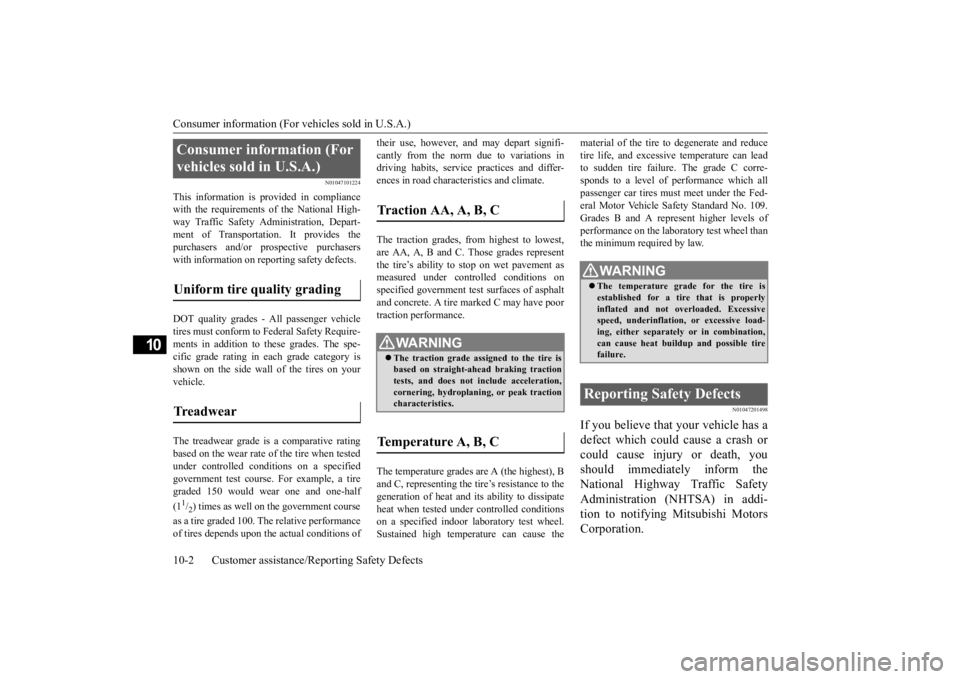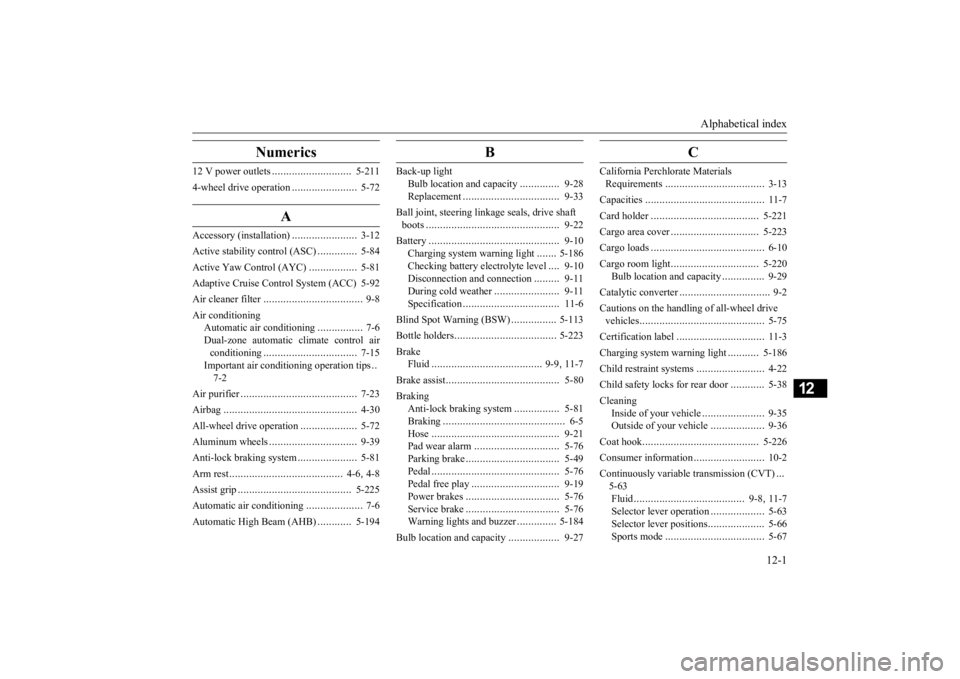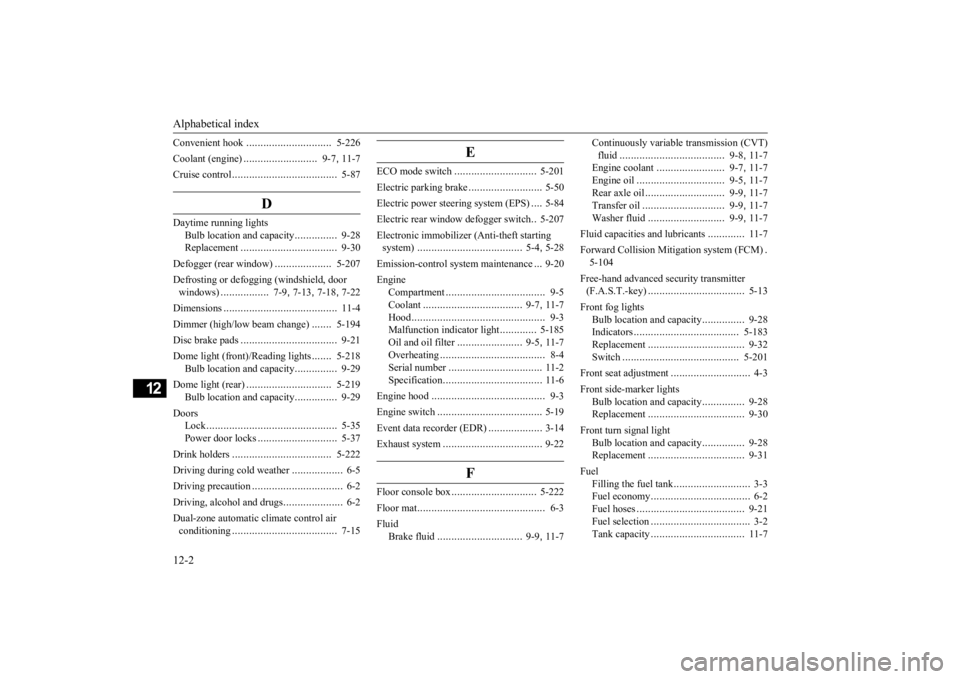climate control MITSUBISHI ECLIPSE CROSS 2020 (in English) User Guide
[x] Cancel search | Manufacturer: MITSUBISHI, Model Year: 2020, Model line: ECLIPSE CROSS, Model: MITSUBISHI ECLIPSE CROSS 2020Pages: 427, PDF Size: 78.05 MB
Page 347 of 427

Dual-zone automatic climate contro
l air conditioning (if so equipped)
7-22 Comfort controls
7
N00731701616
In normal conditions, use the system in the AUTO mode and follow these procedures: 1. Push the AUTO switch. 2. Set the temperature control switch to thedesired temperature. The temperature can be set within a range of around 61 (LO) to 89 (HI) (when the outside temperatureunit of the multi-information display shows °F) or 17 (LO) to 31 (HI) (when the outside temperature unit of the multi-information display shows °C).
The vents, recirculated/outside air, blower speed, temperature adjustment, and ON/OFF of the air conditioning will be controlledautomatically.
N00731801125
Blower speed and vent mode may be con-trolled manually by setting the blower speed selection switch and the MODE switch to the desired positions. To return to automaticoperation, press the AUTO switch.
N00732401636
To remove frost or mist from the windshield and door windows, use the MODE switch or defogger switch (“ ” or “ ”). Use this setting to keep the windshield and door windows clear of mist, and to keep the leg area heated (when driving in rain orsnow).
Operating the air conditioning system (automatic mode)
NOTE
Set the temperature at approximately 75 (when the outside temperature unit of the multi-information display shows °F) or 24 (when the outside temperature unit of the multi-information display shows °C) undernormal conditions. When the engine coolant temperature is low, the air temperature from the heater will be cool/cold until the engine warms up, even if you have selected warm air with the temper-ature switch. To prevent the windshield and windows from fogging up, the vent mode will be changed to “ ” and the blower speed will be reduced.
Operating the air conditioning system (manual mode)
Defrosting or defogging (wind- shield, door windows)
CAUTION For safety, make sure you have a clear view through all the windows.
For ordinary defrosting
BK0277700US.bo
ok 22 ページ 2019年3月8日 金曜日 午前9時23分
Page 380 of 427

Tires
Vehicle care and maintenance 9-15
9
EXAMPLE: DOT MA L9 ABCD 1504
The treadwear grade is a comparative rating based on the wear rate of the tire when tested under controlled conditions on a specified government test course. For example, a tiregraded 150 would wear one and one-half (11/2) times as well on the government course
as a tire graded 100. The relative performance of tires depends upon the actual conditions oftheir use, however, and may depart signifi- cantly from the norm due to variations in driving habits, service practices and differ-ences in road characteristics and climate. The traction grades, from highest to lowest, are AA, A, B and C. Those grades represent the tire’s ability to stop on wet pavement asmeasured under controlled conditions on specified government test surfaces of asphalt and concrete. A tire marked C may have poortraction performance.
The temperature grades are A (the highest), B and C, representing the tire’s resistance to the generation of heat and its ability to dissipate heat when tested under controlled conditionson a specified indoor laboratory test wheel. Sustained high temperature can cause the material of the tire to degenerate and reducetire life, and excessive temperature can lead to sudden tire failure. The grade C corre- sponds to a level of performance which allpassenger car tires must meet under the Fed-eral Motor Vehicle Safety Standard No. 109. Grades B and A represent higher levels of performance on the laboratory test wheel thanthe minimum required by law.
N00939302008
Proper tire inflation pressure is essential forthe safe and satisfactory operation of your vehicle. The wrong tire pressure will cause problems in three major areas: Safety Too little pressure increases flexing in the tire and can cause tire failure. Too much pressure can cause a tire to lose its abilityto cushion shock. Objects on the road and potholes could then cause tire damage that may result in tire failure.
DOT
Department of Transporta- tion This symbol certifies that the tire is in compliance with the U.S. Department of Trans- portation tire safety stan-dards, and is approved for highway use.
MA
Code representing the tire manufacturing location. (2 digits)
L9 ABC D
Code representing the tire size. (2 digits)Code used by tire manufac- turer. (1 to 4 digits)
15
Number representing the week in which the tire was manufactured. (2 digits)
04
Number representing the year in which the tire was manufactured. (2 digits)
Treadwear, Traction and Temper- ature Grades Treadwear Traction
TemperatureTire inflation pressures
BK0277700US.bo
ok 15 ページ 2019年3月8日 金曜日 午前9時23分
Page 407 of 427

Consumer information (For vehicles sold in U.S.A.) 10-2 Customer assistance/Reporting Safety Defects
10
N01047101224
This information is provided in compliance with the requirements of the National High-way Traffic Safety Administration, Depart- ment of Transportation. It provides the purchasers and/or prospective purchaserswith information on reporting safety defects. DOT quality grades - All passenger vehicle tires must conform to Federal Safety Require-ments in addition to these grades. The spe- cific grade rating in each grade category is shown on the side wall of the tires on yourvehicle. The treadwear grade is a comparative rating based on the wear rate of the tire when tested under controlled conditions on a specified government test course. For example, a tiregraded 150 would wear one and one-half (11/2) times as well on the government course
as a tire graded 100. The relative performance of tires depends upon the actual conditions of
their use, however, and may depart signifi- cantly from the norm due to variations in driving habits, service practices and differ- ences in road characteristics and climate. The traction grades, from highest to lowest, are AA, A, B and C. Those grades representthe tire’s ability to stop on wet pavement asmeasured under controlled conditions on specified government test surfaces of asphalt and concrete. A tire marked C may have poortraction performance. The temperature grades are A (the highest), B and C, representing the tire’s resistance to thegeneration of heat and its ability to dissipate heat when tested under controlled conditions on a specified indoor laboratory test wheel.Sustained high temperature can cause the
material of the tire to degenerate and reduce tire life, and excessive temperature can lead to sudden tire failure. The grade C corre- sponds to a level of performance which allpassenger car tires must meet under the Fed- eral Motor Vehicle Safety Standard No. 109. Grades B and A represent higher levels ofperformance on the laboratory test wheel than the minimum required by law.
N01047201498
If you believe that your vehicle has a defect which could cause a crash or could cause injury or death, you should immediately inform the National Highway Traffic SafetyAdministration (NHTSA) in addi- tion to notifying Mitsubishi Motors Corporation.
Consumer information (For vehicles sold in U.S.A.) Uniform tire quality grading Treadwear
Traction AA, A, B, C
WA R N I N G The traction grade assigned to the tire is based on straight-ahead braking traction tests, and does not include acceleration, cornering, hydroplaning, or peak tractioncharacteristics.
Temperature A, B, C
WA R N I N G The temperature grade for the tire is established for a tire that is properly inflated and not overloaded. Excessive speed, underinflation, or excessive load-ing, either separately or in combination, can cause heat buildup and possible tire failure.
Reporting Safety Defects
BK0277700US.bo
ok 2 ページ 2019年3月8日 金曜日 午前9時23分
Page 420 of 427

Alphabetical index
12-1
12
Numerics
12 V power outlets
............................
5-211
4-wheel drive operation
.......................
5-72
A
Accessory (installation)
.......................
3-12
Active stability control (ASC)
..............
5-84
Active Yaw Control (AYC)
.................
5-81
Adaptive Cruise Control System (ACC) 5-92Air cleaner filter
...................
................
9-8
Air conditioning
Automatic air conditioning
................
7-6
Dual-zone automatic climate control air conditioning
................
.................
7-15
Important air conditioning operation tips
..
7-2
Air purifier
....................
.....................
7-23
Airbag
.......................
........................
4-30
All-wheel drive operation
....................
5-72
Aluminum wheels
...............................
9-39
Anti-lock braking system
.....................
5-81
Arm rest
.....................
...................
4-6
, 4-8
Assist grip
.....................
...................
5-225
Automatic air conditioning
....................
7-6
Automatic High Beam (AHB)
............
5-194
B
Back-up light
Bulb location and capacity
..............
9-28
Replacement
...................
...............
9-33
Ball joint, steering linkage seals, drive shaft boots
.........................
......................
9-22
Battery
........................
......................
9-10
Charging system warning light
.......
5-186
Checking battery electrolyte level
....
9-10
Disconnection and connection
.........
9-11
During cold weather
.......................
9-11
Specification
...................
...............
11-6
Blind Spot Warning (BSW)
................
5-113
Bottle holders
...................
.................
5-223
Brake
Fluid
....................
...................
9-9
, 11-7
Brake assist
......................
..................
5-80
Braking
Anti-lock braking system
................
5-81
Braking
.......................
....................
6-5
Hose
.......................
......................
9-21
Pad wear alarm
...............
...............
5-76
Parking brake
..................
...............
5-49
Pedal
.......................
......................
5-76
Pedal free play
................
...............
9-19
Power brakes
..................
...............
5-76
Service brake
..................
...............
5-76
Warning lights and buzzer
..............
5-184
Bulb location and capacity
..................
9-27
C
California Perchlorate Materials Requirements
..................
.................
3-13
Capacities
.....................
.....................
11-7
Card holder
...................
...................
5-221
Cargo area cover
................
...............
5-223
Cargo loads
...................
.....................
6-10
Cargo room light
................
...............
5-220
Bulb location and capacity
...............
9-29
Catalytic converter
................
................
9-2
Cautions on the handling of all-wheel drive vehicles
.......................
.....................
5-75
Certification label
...............................
11-3
Charging system warning light
...........
5-186
Child restraint systems
........................
4-22
Child safety locks for rear door
............
5-38
Cleaning
Inside of your vehicle
......................
9-35
Outside of your vehicle
...................
9-36
Coat hook
......................
...................
5-226
Consumer information
.........................
10-2
Continuously variable transmission (CVT)
...
5-63 Fluid
..................
.....................
9-8
, 11-7
Selector lever operation
...................
5-63
Selector lever positions
....................
5-66
Sports mode
..................
.................
5-67
BK0277700US.bo
ok 1 ページ 2019年3月8日 金曜日 午前9時23分
Page 421 of 427

Alphabetical index 12-2
12
Convenient hook
...............
...............
5-226
Coolant (engine)
..........................
9-7
, 11-7
Cruise control
....................
.................
5-87
D
Daytime running lights
Bulb location and capacity
...............
9-28
Replacement
.................
.................
9-30
Defogger (rear window)
....................
5-207
Defrosting or defogging (windshield, door windows)
.................
7-9
, 7-13
, 7-18
, 7-22
Dimensions
...................
.....................
11-4
Dimmer (high/low beam change)
.......
5-194
Disc brake pads
.................
.................
9-21
Dome light (front)/Reading lights
.......
5-218
Bulb location and capacity
...............
9-29
Dome light (rear)
...............
...............
5-219
Bulb location and capacity
...............
9-29
Doors
Lock
......................
........................
5-35
Power door locks
............................
5-37
Drink holders
....................
...............
5-222
Driving during cold weather
..................
6-5
Driving precaution
................
................
6-2
Driving, alcohol and drugs
.....................
6-2
Dual-zone automatic climate control air conditioning
....................
.................
7-15
E
ECO mode switch
.............................
5-201
Electric parking brake
..........................
5-50
Electric power steering system (EPS)
....
5-84
Electric rear window defogger switch
..5-207
Electronic immobilizer (Anti-theft starting system)
.....................
................
5-4
, 5-28
Emission-control system maintenance
...
9-20
Engine
Compartment
..................
.................
9-5
Coolant
...................
................
9-7
, 11-7
Hood
.......................
........................
9-3
Malfunction indicator light
.............
5-185
Oil and oil filter
.......................
9-5
, 11-7
Overheating
....................
.................
8-4
Serial number
.................
................
11-2
Specification
...................
................
11-6
Engine hood
....................
....................
9-3
Engine switch
.....................
................
5-19
Event data recorder (EDR)
...................
3-14
Exhaust system
...................
................
9-22
F
Floor console box
..............................
5-222
Floor mat
.........................
....................
6-3
Fluid
Brake fluid
..............................
9-9
, 11-7
Continuously variable transmission (CVT) fluid
....................
.................
9-8
, 11-7
Engine coolant
........................
9-7
, 11-7
Engine oil
...............................
9-5
, 11-7
Rear axle oil
............................
9-9
, 11-7
Transfer oil
.............................
9-9
, 11-7
Washer fluid
...........................
9-9
, 11-7
Fluid capacities and lubricants
.............
11-7
Forward Collision Mitigation system (FCM)
.
5-104 Free-hand advanced security transmitter (F.A.S.T.-key)
.................
.................
5-13
Front fog lights
Bulb location and capacity
...............
9-28
Indicators
..................
...................
5-183
Replacement
.................
.................
9-32
Switch
......................
...................
5-201
Front seat adjustment
............................
4-3
Front side-marker lights
Bulb location and capacity
...............
9-28
Replacement
.................
.................
9-30
Front turn signal light
Bulb location and capacity
...............
9-28
Replacement
.................
.................
9-31
Fuel
Filling the fuel tank
...........................
3-3
Fuel economy
...................
................
6-2
Fuel hoses
.....................
.................
9-21
Fuel selection
...................
................
3-2
Tank capacity
................
.................
11-7
BK0277700US.bo
ok 2 ページ 2019年3月8日 金曜日 午前9時23分